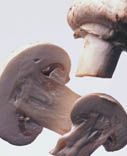Portabellas have a deep, meat-like texture and full-bodied flavor, which makes them popular in vegetarian dishes. The Crimini mushroom, often called a baby Portabella, basically, is an immature Portabella, with unfolded gills. It has a firm texture and a deep, dense flavor. With their soft, spongy texture, Shiitakes are suitable for most cooking techniques, while Porcinis are especially suited for Italian or European dishes, suggests Kate Foley, industrial sales division, Phillips Foods, Inc., Kennett Square, Penn. The company is a subsidiary of Phillips Mushroom Farms, the largest grower and marketer of specialty mushrooms in the U.S.
Cooking Considerations
Using the right mushroom is essential, as it imparts flavor, color and water. For example, manufacturers formulating a white sauce will find that fresh Portabellas have a dark liquid that leeches out of them, darkening the sauce's color. In this case, it would be better to use a blanched Portabella, which does not lose noticeable color, explains Jim Fleming, sales and marketing at Phillips. Using a fresh product in applications such as steak sauce or brown sauce is fine, however.Portabellas make lasagnas tastier, but the moisture released when fresh mushrooms are cooked may create excess free-moisture that requires adjustments to the formula. However, blanched mushrooms contain significantly less water and may be better suited for applications where excess moisture is an issue.

Portabellas and Criminis, the most recognizable mushrooms in the U.S., have a robust flavor that does well in beef dishes, dark gravies, tomato-based sauces and many other applications. However, in the past decade, Shiitake mushrooms also have gone mainstream. They have a delicate, yet hearty, flavor and stand up well in stir-frys, noodle bowls, rice dishes and vegetarian foods. “Many vegetarians rely on Oriental and Indian recipes because so many of those recipes are vegetarian-based,” says Foley.
A Mushroom for Any Occasion
The company provides mushrooms for any process. Mushrooms are available blanched and fresh IQF, refrigerated, dried, or fresh. A wide variety of dice sizes, slice thicknesses, and particulate sizes of dried and pureed mushrooms are available—depending on the further processing requirements of the manufacturer. The company maintains a large variety of ingredient options to accommodate a wide breadth of mushroom manufacturing applications.
For more information:
Kate Foley at 847-459-6877, kfoley@Phillipsfoodsinc.com or
Rick Angelucci at 610-925-0520, rangelucci@phillipsfoodsinc.com
Phillips Foods Inc. WRITE IN 203